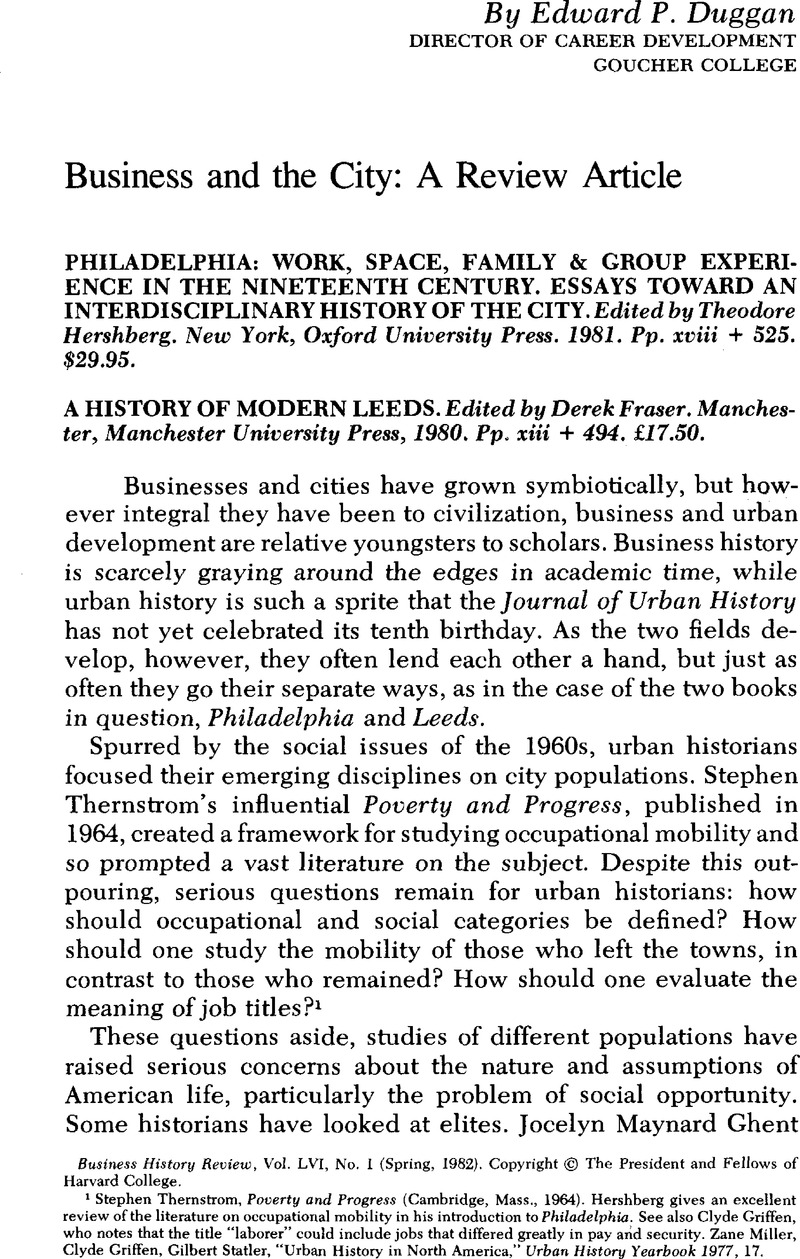No CrossRef data available.
Published online by Cambridge University Press: 11 June 2012

1 Thernstrom, Stephen, Poverty and Progress (Cambridge, Mass., 1964).Google Scholar Hershberg gives an excellent review of the literature on occupational mobility in his introduction to Philadelphia. See also Clyde Griffen, who notes that the title “laborer” could include jobs that differed greatly in pay and security. Zane Miller, Clyde Griffen, Gilbert Statler, “Urban History in North America,” Urban History Yearbook 1977, 17.
2 Ghent, Jocelyn Maynard and Jaher, Frederic Cople, “The Chicago Business Elite, 1830–1930: A Collective Biography,” Business History Review (Autumn 1976), 288–328.CrossRefGoogle Scholar See also Ingham, John, The Iron Barons: A Social Analysis of an American Urban Elite, 1874–1975 (Westport, Connecticut, 1978)Google Scholar, and Lee Benson, “Philadelphia Elites and Economic Development: a Quasi-Public Innovation during the First American Organizational Revolution, 1825–1861,” and Jaher, F. C., “Old and New Elites and Entrepreneurial Activity in New York City from 1780 to 1850,” in Porter, Glenn, Mulligan, William Jr., eds., Elites and Economic Development, Regional Economic History Research Center Working Papers (Spring 1978).Google ScholarHareven, Tamara, Langenbach, Randolph, Amoskeag: Life and Work in an American Factory City (New York, 1978)Google Scholar. Hirsch, Susan, The Roots of the American Working Class: The Industrialization of Crafts in Newark, 1800–1860 (Philadelphia, 1978)Google Scholar, Cumbler, John T., Working-Class Community in Industrial America: Work, Leisure, and Struggle in Two Industrial Cities, 1880–1930 (Westport, Conn., 1979).Google Scholar
3 Warner, Sam Bass Jr, The Private City (Philadelphia, 1968)Google Scholar; The Urban Wilderness (New York, 1972). Goldfield, David, Brownell, Blaine, Urban America: From Downtown to No Town (Boston, 1979).Google ScholarSchnore, Leo, ed., The New Urban History (Princeton, N.J., 1975).Google ScholarCain, Louis, Sanitation Strategy for a Lakefront Metropolis: The Case of Chicago (DeKalb, Ill., 1978).Google Scholar
4 Cochran, Thomas, Business in American Life (New York, 1972).Google ScholarChandler, Alfred D. Jr, The Visible Hand (Cambridge, Mass., 1977).Google Scholar
5 Bruchey, Stuart, ed., Small Business in American Life (New York, 1980).Google Scholar Reviewed by Jim Heath in Business History Review, Summer 1981.
6 Bureau of Labor Statistics, How American Buying Habits Change, 1959. Builds on BLS statistics 1888–1950. Woodhouse, Chase Going, “The Standard of Living at the Professional Level, 1816–17 and 1926–27,” Journal of Political Economy, vol. 37, 1929, 552–572.CrossRefGoogle Scholar Budgets of government officials in Washington, D.C. Zimmerman, Carle C., “The Family Budget as a Tool for Sociological Analysis,” American Journal of Sociology, May 1928, 901–911.CrossRefGoogle Scholar U.S. Department of Agriculture. Studies of Family Living in the United States and Other Countries: An Analysis of Material and Method, Miscellaneous Publication No. 223, December 1935; 600-page annotated bibliography. Byington, Margaret, Homestead: The Households of a Mill Town (1910, reprinted by University Center for International Studies in 1974).CrossRefGoogle ScholarBell, Carolyn Shaw, Consumer Choice in the American Economy (New York, 1967).Google ScholarBrady, Dorothy, “Consumption and the Style of Life,” in Davis, Lance et al., American Economic Growth: An Economist's History of the United States (New York, 1972), 61–89Google Scholar; Krooss, Herman, American Economic Development: The Progress of a Business Civilization (New York, 1974)Google Scholar, chapter 2. Samson, Peter, “The Department Store, Its Past and Its Future: A Review Article,” Business History Review (Spring 1981), 26–34.CrossRefGoogle Scholar
7 Clyde and Griffen, Sally, Natives and Newcomers, the Ordering of Opportunity in Mid-Nineteenth Century Poughkeepsie (Cambridge, Mass., 1978)CrossRefGoogle Scholar, reviewed by Lynn Lees in Urban History Yearbook, 1979, 143–144. Weiss, Janice, “Educating for Clerical Work: The Nineteenth Century Private Commercial School,” Journal of Social History (Spring 1981), 407–423CrossRefGoogle Scholar; Aron, Cindy S. “To Barter Their Souls for Gold: Female Clerks in Federal Government Offices, 1862–1890,” Journal of American History (March 1981), 835–853CrossRefGoogle Scholar; Silverstone, Rosalie, “Office Work for Women: An Historical Review,” Business History (January 1976), 98–110CrossRefGoogle Scholar; Porter Benson, Susan, “The Cinderella of Occupations: Managing the Work of Department Store Saleswomen, 1900–1940,” Business History Review (Spring 1981), 1–25CrossRefGoogle Scholar; Struthers, James, “A Profession in Crisis: Charlotte Whitton and Canadian Social Work in the 1930's,” Canadian Historical Review (June 1981), 69–85.Google Scholar
8 Blouin, Francis X. Jr, The Boston Region 1810–50: A Study of Urbanization (Ann Arbor, Mich., 1980).Google Scholar